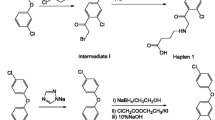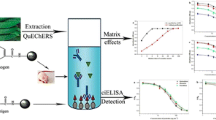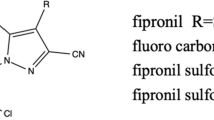Abstract
To enhance the sensitivity of an ELISA developed for the acaricide/insecticide fenazaquin, the length of the spacer arm attached to the 7-position of the quinazoline ring in the hapten (H-I) used previously as an immunogen was shortened, and this modified hapten (H-IV) was then used as an immunogen. The new immunogen used to raise polyclonal antibodies was designated 3-(4-(4-tert-butylbenzyloxy)quinazolin-7-ylcarbamoyl)propanoic acid. Under optimized conditions of a competitive indirect ELISA (ciELISA), the former IC50 value of 96.97 ng/mL was reduced to 42.13 ng/mL, and the detection range was 10.96–161.91 ng/mL, the lowest detection limit being 1.8 ng/mL. HPLC was run to compare with and to validate the ELISA with fortified fruit and water samples; the correlation was 0.997–1.000 (n=4-5) with a slope of 0.905–1.112. The recoveries of fenazaquin from fortified samples by the ELISA ranged from 90.61 to 115.12%, which is acceptable as an ELISA for residue analysis.
Similar content being viewed by others
Abbreviations
- ELISA:
-
enzyme-linked immunosorbent assay
- DMF:
-
N,N-dimethylformamide
- HPLC:
-
high performance liquid chromatography
- IgG-HRP:
-
Immunoglobulin G-horse radish peroxidase
References
Abad A and Montoya A (1997) Development of an enzyme-linked immunosorbent assay to carbaryl. 2. Assay optimization and application to the analysis of water samples. J Agric Food Chem 45, 1495–1501.
Gee SJ, Hammock BD, and Van Emon JM (1994) In A User’s Guide to Environmental Immunochemical Analysis; EPA/540/R-94/509; U.S. EPA. Office of Research and Development, Environmental Monitoring Systems Laboratory, Las Vegas, NV, U.S.A.
Hackler RE, Suhr RG, Sheets JJ, Hatton CJ, Johnson PL, Davis LN, Edie RG, Kaster SV, Jourdan GP, Jackson JL, and Krumkalns EV (1994) Chemistry and miticidal activity of fused pyrimidine derivatives of fenazaquin. In Advances in the Chemistry of Insect Control III, Briggs GG (ed.), pp. 70–84. Royal Soc Chem, Cambridge, UK.
Harrison RO, Braun AL, Gee SJ, O’Brien DJ, and Hammock BD. (1989) Evaluation of an enzyme-linked immunosorbent assay (ELISA) for the direct analysis of molinate(Ordram) in rice field water. Agric Food Immunol 1, 37–51.
Kumar V, Tewary DK, Ravindranath SD, Shanker A. (2004) Investigation in tea on fate of fenazaquin residue and its transfer in brew. Food and Chemical Toxicology 42, 423–428.
Langone JJ and Van Vunakis H (1975) Radioimmunoassay for dieldrin and aldrin. Res Commun Chem Pathol Pharmaco 10, 163–171.
Lee JK, Kyung KS, Kwon JW, Jung IS, and Ahn KC (1993) Degradation of the acaricide fenazaquin in soil. In Plant Growth and Environment, p. 212. Proc Symp Korean Agric Chem Soc, Seoul, Korea.
Lee JK, Ahn KC, Park OS, Ko YK, and Kim DW (2002) Development of an immunoassay for the residues of the herbicide bensulfuron-methyl. J Agric Food Chem 50, 1791–1803.
Lee JK, Ahn KC, Stoutamire DW, Gee SJ, and Hammock BD (2003) Development of an enzyme-linked immunosorbent assay for the detection of the organophosphorus insecticide acephate. J Agric Food Chem 51, 3695–3703.
Lee JK, Kim YJ, Lee EY, Kim DK, and Kyung KS (2005) Development of an ELISA for the detection of fenazaquin residues in fruits. Agric Chem Biotechnol 48, 16–25.
Lee JK, Park SH, Lee EY, Kim YJ, and Kyung KS (2004) Development of an ELISA for the detection of the residues of the fungicide iprovalicarb. J Agric Food Chem 52, 6680–6686.
Longhurst C, Bacci L, Buendia J, Hatton CJ, Petitprez J, and Tsakonas P (1992) Fenazaquin, a novel acaricide for the management of spider mites in a variety of crops. Brighton Crop Prot Conf Pests Dis 2, 51.
Rodbard D (1981) Mathematics and statistics of ligand assay: an illustrated guide. In Ligand Assay: Analysis of International Developments on Isotopic and Nonisotopic Immunoassay, Langan J and Clapp JJ (eds.), pp.45–99. Masson Publishing, New York, NY, U.S.A.
Shan G, Stoutamire DW, Wengatz I, Gee SJ, and Hammock BD (1999) Development of an immunoassay for the pyrethroid insecticide esfenvalerate. J Agric Food Chem 47, 2145–2155.
Sugawara Y, Gee SJ, Sanborn JR, Gilman SD, and Hammock BD (1998) Development of a highly sensitive enzyme-linked immunosorbent assay based on polyclonal antibodies for the detection of polychlorinated dibenzo-p-dioxins. Anal Chem 70, 1092–1099.
Vanderlaan M, Stanker LH, and Watkins BE (1988) Improvement and application of an immunoassay for screening environmental samples for dioxin contamination. Environ Toxicol Chem 7, 859–870.
Voller A, Bidwell DE, and Bartlett A (1976) Enzyme immunoassay in diagnostic medicine: theory and practice. Bull WHO 53, 55–65.
Author information
Authors and Affiliations
Corresponding author
Rights and permissions
About this article
Cite this article
Kyung, K.S., Kim, D.K., Kim, Y.J. et al. An enhanced ELISA for the acaricide/insecticide fenazaquin. J. Korean Soc. Appl. Biol. Chem. 52, 380–388 (2009). https://doi.org/10.3839/jksabc.2009.068
Received:
Accepted:
Issue Date:
DOI: https://doi.org/10.3839/jksabc.2009.068




